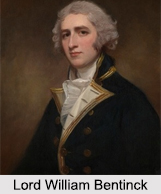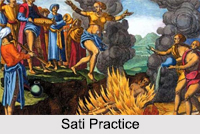 William Cavendish Bentinck succeeded Lord Amherst as the Governor General of India. He took over the charge of Indian administration in the year 1828. Bentinck took effective steps to root out social evils like "Sati" and infanticide. Bentinck was a benevolent administrator and he reorganized and established the law and order of the country.
William Cavendish Bentinck succeeded Lord Amherst as the Governor General of India. He took over the charge of Indian administration in the year 1828. Bentinck took effective steps to root out social evils like "Sati" and infanticide. Bentinck was a benevolent administrator and he reorganized and established the law and order of the country.
Early Life of Lord William Bentinck
Lord William Bentinck was born in Buckinghamshire, the second son of Prime Minister William Bentinck and Lady Dorothy. Upon the third duke`s marriage to Lady Dorothy, he changed the family name to Cavendish-Bentinck. He was a liberal reformist who took active part in the reform movement of England. In 1808, he served in the "Battle of Corunna" and by 1811, had been appointed representative to the Court of the Two Sicilies. He promoted plans for a self-governing and unified Italy, until he was evoked to Britain in 1815.
Lord William Bentinck as a Governor in India
Lord William Bentinck was a benevolent administrator and established the law and order of the country. He suppressed the operation of the thugs, provided a larger share to the Indians in the subordinate services, initiated the liberty of the Press and also took vital decisions regarding the educational system prevailed in India. None of Bentinck`s predecessors handled the problems of social evil in India as Bentinck did. He tried to reform the Hindu society by abolition of the cruel rite of "Sati" and the suppression of the infanticide. The cult of "Sati" was prevalent in Bengal in 19th century. William Bentinck declared "Sati" as illegal. In his a solemn aim to reform India, he got the help of leaders like Raja Ram Mohan Roy. Later, by the "Regulation No XVII" of December1829, he declared the practice of "Sati" illegal. Thus the practice of "Sati" was completely abolished from the contemporary society with the assistance of William Bentinck.
Infanticide was popular in the region of Banaras and Gujarat. Thetribes like "Jharija Rajputs", "Jats" and "Mewatis" performed this practice. In spite of the adequate legal measures, infanticide was still continuing in its full form. Bentinck reorganized the Bengal Regulation XXI of 1795 and Regulation III of 1804, thereby adopted vigorous steps to suppress the immoral and inhuman practice.
The Charter Act of 1813 was passed in the time of Lord William Bentinck. According to the act, control of the East India Company was abolished. The Governor General of Bengal became the Governor General of India. This Act added a law member to the management council of the governor general. Bishops of Mumbai, Chennai, and Kolkata were to be selected for the benefit of the Christians in India. He also issued legislative measures declaring the punishment for those who provided protection to the thugs. While the general public opinion was moved against the Government measure during the abolition of "Sati", the public opinion solidly supported the suppression of thugs in 1830. After the law was passed, Colonel Smith arrested about 1500 thugs and subjected them to death. Due to the continuous legislative actions adopted by Bentinck, the thugs on an organizing scale ceased to exist after 1837. He reduced the discrimination of recruitment processes in the public offices. Though the immediate effect of the Charter clause was very little, it laid down a very important and healthy principle. In this way Bentinck was a social reformer.
Unlike his predecessors, Bentinck advocated the liberty of Press. He never suppressed the Press to describe even the evil deeds of the Company. By adopting several legislative measures, Bentinck removed all restrictions from the Indian Press. Moreover, he advocated several educational reforms in order to ensure an all round social progress in India. The "Macaulayain System" of education had profoundly affected the moral and the intellectual character of the people of India. He announced that the British government should promote European literature and science by making English the language of higher education.
The Bengal government attempted to establish an English school or a school in each district using both English and the local language. In 1854, the government took it over and renamed it Presidency College, emphasizing the writings of Bacon, Johnson, Milton and Shakespeare along with history, science, moral philosophy and political economy. Thus the initiation of the English literature and different forms of education, Bentinck induced reforms in the educational system prevailed in India. The primary aim of Bentinck was to remove the social abuses and to liberate the people from the shackles of superstitions.
Bentinck appointed two committees, one military and one civil to make the recommendations for effecting economy in expenditure. Under special instructions from the Courts of directors, Bentinck reduced the "Bhatta", i.e. extra additional allowance paid to military officers. The new rules decreed that in case of troops stationed within 400 miles of Kolkata one-half "Bhatta" was allowed. The allowances of the civil servants were also reduced. The land Revenue Settlement of the North-western provinces yielded better revenues. Further, Bentinck employed Indians wherever possible in places of the highly paid Europeans. Through the financial reforms undertaken by Bentinck, opium trade was licensed and regularized. It was declared that in future opium could be exported only through the port of Mumbai. This would give the Company a share in the profits in form of duties. Bentinck had also stimulated the economy by the encouraging iron and coal production,tea and coffee plantations and irrigation schemes. The governor general William Bentinck reorganized the judiciary system established by Lord Cornwallis.
He was a true liberal and in his reign of 7 years, the Indians achieved a socio-economic progress, which was shattered during his predecessors. Though he did not worked for administrative reforms, yet the legislative, financial and the educational reforms he undertook had liberated India from the social abuses. Bentinck had a forward looking mind and to encourage free trade he abolished transit duties, developed steam transport by river and ocean, encouraged tea and coffee cultivation and production of iron and coal, and planned a network of roads, drainage and irrigation of canals. For his liberal ideas and reform activities Lord William Bentinck earned the admiration of the Indians.
Personal Life of Lord William Bentinck
William Bentinck married Lady Mary who was the daughter of Arthur Acheson, on 18 February 1803. He died in Paris on 17 June 1839, aged 64. Lord



















